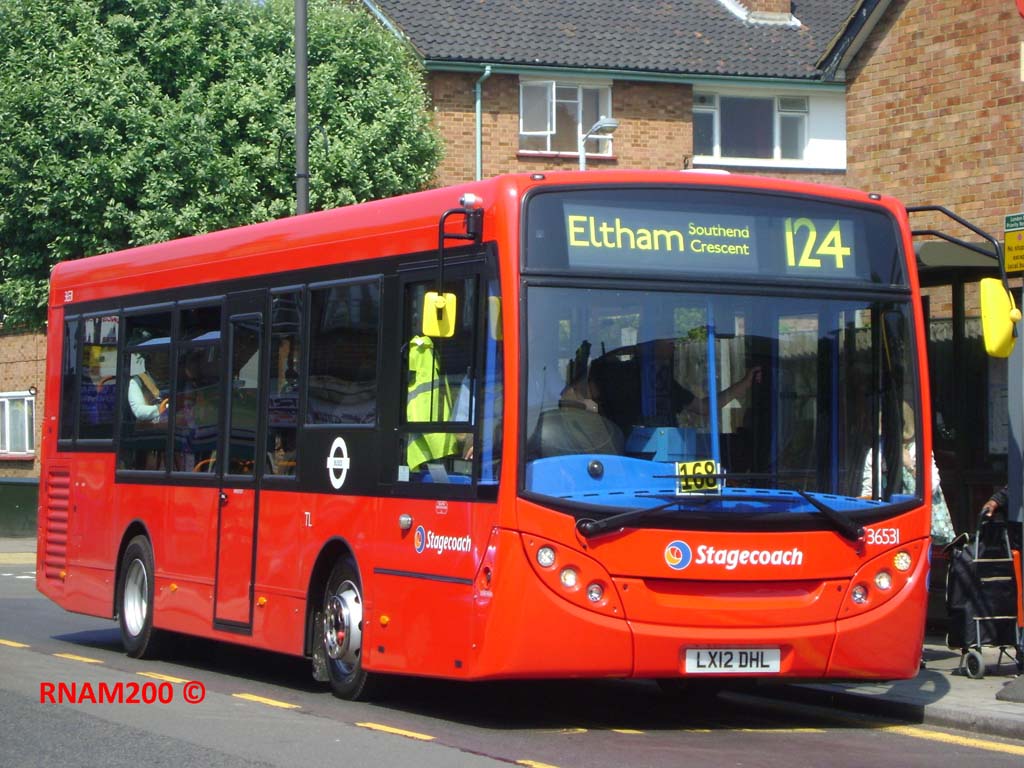 | Photo © RNAM200 (Robert Mighton). |
Home | Bus routes | Operational details | Service changes | Operators & Garages | Photo gallery
A new contract on the 124 from May 2012 called for new buses, and predictably these materialised in the form of short E20D/Enviro200Darts. 36531 (LX12 DHL) was photographed in Sangley Road, Catford, on 22 May 2012. The centrally mounted offside emergency door gives away this bus's status as a single doored vehicle.
 | Photo © RNAM200 (Robert Mighton). |
The 124 itself is a rather roundabout local service linking Eltham and Catford in South East London. Traditionally buses stuck to main roads and the 124 already ran along an unusual number of side roads when introduced on 4 May 1938. It was a double deck replacement for the single deck 209, which ran from Eltham (Southend Crescent) via Mottingham, Grove Park, St. Mildred's Road to Catford, then via Woolstone Road to Forest Hill (Waldram Road). The 209 was operated from Sidcup, but the 124 ran from Catford garage, and differed from the 209 between Grove Park and Catford by running along Verdant Lane, Hazelbank Road, Torridon Road and Sangley Road. Apart from Sangley Road these minor roads, as was the norm in those days, were previously unserved, though in fairness were largely undeveloped before.
Since then, the 124 has added several diversions to its route. Between Mottingham and Grove Park, Dunkery Road was added in 1951. In 1961 came a new Sunday afternoon variant, the 124A which continued beyond Eltham to Bexley Hospital, the first central bus route to go there. Meanwhile the main 124 service was extended to Woolwich, first replacing the 126 to Welling via Falconwood, then on via Plumstead (96 route), but only on Mondays to Saturdays, the 124A providing the whole Sunday service.
The 1980s proved rather eventful for the 124. It was cut back to Welling in 1976, to Eltham in November 1985 (the 124A losing its suffix at this time) and to Catford in June 1987. The 160 was diverted to replace the Falconwood section of the 124 – this is now the B16 – while Woolstone Road was covered by the 108B. The 124 was diverted between Eltham and Mottingham via Middle Park in February 1990, assisting the 160 between Eltham and Kingsground.
A tight turn out of Middle Park Avenue meant the route had to be converted to minibus operation and has been causing problems ever since. However, further narrow streets were added in 1993 when the route was diverted through the Excalibur Estate in Catford – the last remaining estate of prefab houses built after the second world war, now being redeveloped after conservationists and about half the residents lost a big battle with Lewisham council and the remaining residents!
DRL class Dennis Darts eventually replaced the Mercedes 811Ds used since 1990. A bad mistake made around the same time was to simplify the peak hour service structure, which had previously run every 15 minutes end-to-end with a 7½ minute service between Grove Park and Catford, reflecting demand, but was altered to every 12 minutes throughout to match the offpeak service. Even now the peak service is only every 10 minutes.
A new contract from 1999 called for low floor Darts, but the original 9.4m versions purchased proved too large to pass their route test and had to be used on other routes instead. Eventually the 8.8m Darts shown above were phased in, although they offer considerably fewer seats than the DRLs with only one extra morning peak journey introduced to compensate. Despite much tinkering around to try to relieve the route, including diversion of route 160 via Sangley Road and a modest frequency increase on the 284, the 124 still suffers from chronic overcrowing at peak times. Why the obvious solution of reverting to the service pattern of the early 1990s is not pursued is beyond me.
Navigation
| Previous | Next | |
| Chronologically | RV1 | 52 |
| Numerically | 122 | 125 |
Photo Gallery | Bus route list | Operational details | Service changes | Operators & Garages